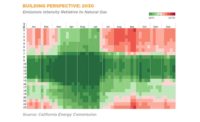Reducing Embodied Carbon and Operational Emissions in Buildings

The different stages of the carbon cycle in the built environment, according to a new practice guide on the life-cycle assessment of embodied carbon in buildings.
Graphic courtesy of the Carbon Leadership Forum
Last week, at the Global Climate Action Summit in San Francisco, Microsoft announced it is the first large corporate user of a new tool to track the carbon emissions of raw building materials. Microsoft is piloting the tool, called the Embodied Carbon in Construction Calculator, or EC3, in the remodel of its 72-acre Seattle campus.
The open-source EC3, which is running on Microsoft Azure, was developed by Skanska with the University of Washington Carbon Leadership Forum, Interface and C-Change Labs. Skanska is purposely carving out embodied carbon in materials in construction—from the cradle to the grave—because it is manageable, said Stacy Smedley, director of sustainability for Skanska USA Building Inc., at the Carbon Smart Building Day, held on Sept. 11 in advance of the summit and attended by more than 300 people in the buildings sector.
"Benchmarking and understanding data is important" but existing calculators have different baseline data, which is not necessarily open source, so using them results in different numbers, added Smedley. EC3 is not only open source, it is free for all to use.
Operational Carbon Emissions
In addition, at the Sept. 12-14 summit, the World Green Building Council (WorldGBC) launched its Net Zero Carbon Buildings Commitment. The 38 initial signatories include 12 businesses, 22 cities and four states and regions. The member businesses, which represent nearly $23 billion in revenue in building and construction supply chain, are pledging to eliminate operational carbon emissions from their business portfolios of more than 10.7 million square meters by 2030. WorldGBC expects this to trigger a wider market transformation to enable net-zero carbon buildings by 2050, said Victoria Kate Burrows, head of advancing net zero for the WorldGBC.
The commitment also represents a pledge by the leaders of member municipalities to enact regulations and/or planning policies that would require all new buildings within their jurisdictions to operate at net-zero carbon by 2050. Some public-sector signatories have made a commitment to get to net-zero carbon operations of buildings they own, operate and develop by 2030.
Ed Mazria, founder of Architecture 2030, introduced the Carbon Smart Materials Palette, which contains an attribute-based approach to embodied carbon reductions in the built environment. The palette identifies key attributes that contribute to a material’s embodied carbon impact, and offers guidelines and options for emissions reductions.
Annually, embodied carbon is responsible for 11% of global GHG emissions and 28% of global building sector emissions, said Mazria. "As we trend toward zero operational emissions, the impact of embodied emissions becomes increasingly significant," he added.
On the building operations side, regarding carbon emissions, Architecture 2030 has set a goal of a decarbonized buildings sector by 2050. Toward that goal, policymakers must embrace a standard for all buildings: new and existing, large and small, and appropriate for any location including dense urban areas where most of the U.S. and global construction will take place over the next two decades, said Mazria. A Zero Net Carbon (ZNC) building is defined as a highly energy-efficient building that produces on-site, or procures, enough carbon-free renewable energy to meet building operations energy consumption annually.
Zero Net Carbon Energy Standard
Toward that end, Architecture 2030 launched a ZNC energy standard several weeks ago. The ZERO Code is a national and international building energy standard for new building construction that integrates cost-effective energy efficiency standards with on-site and/or off-site renewable energy resulting in zero-net-carbon buildings.
The standard includes prescriptive and performance paths for building energy efficiency compliance based on current standards that are widely used by municipalities and building professionals worldwide, according to Architecture 2030. These include the latest ASHRAE Standard 90.1-2016 requirements for minimum building efficiency, the International Green Construction Code (IgCC), ASHRAE Standard 189.1-2017 and any building energy efficiency standard that exceeds ASHRAE Standard 90.1-2016.
The ZERO Code for California, a building energy standard for new nonresidential, high-rise residential and hotel/motel buildings, incorporates the 2019 California Building Energy Efficiency Standards and also includes prescriptive and performance paths for building energy efficiency compliance.
The standard offers a flexible approach for incorporating renewable energy, both through on-site generation and/or off-site procurement, says Architecture 2030. By establishing a flexible approach, the ZERO Code is applicable to all new commercial and institutional buildings, even those in dense urban environments with limited on-site renewable energy generating capacity.
"We are running out of time," said Mazria. "We have to act really fast and globally. Every effort must be scaleable."
For the ZERO Code, a technical support document is available that describes several potential options for off-site procurement of renewable energy within the context of codes, and presents a process for evaluating and assigning a weight to each procurement method.
The ZERO Code is supported by Architecture 2030 Energy Calculators intended to ease the implementation process and reduce errors when applying the prescriptive compliance path. An Application Program Interface (API) for the national and international ZERO Code versions of the software has been developed, enabling the software to be implemented on a website or within an application for smart phones and tablets.
"We need to move faster and try out things that are not exactly right," said Kate Simonen, director of the Carbon Leadership Forum, which organized the Sept. 11 event and published a 33-page primer, called Life-Cycle Assessment of Buildings: A Practice Guide, in June.
LCA for construction is a method used to quantify carbon dioxide emitted during the extraction, manufacture, transport and construction of building materials, together with end-of-life emissions.
One attendee of the Carbon Smart Building Day injected a dose of reality: "There are amazing things happening to bring embodied carbon down in buildings, but declaring net zero on embodied carbon lacks credibility because we don't even know what that means yet," said Don Davies, president of structural engineer Magnusson Klemencic Associates.





